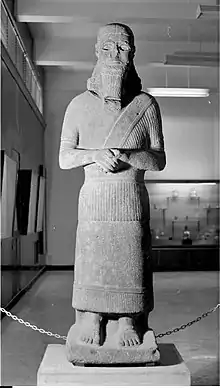Tell Fekheriye bilingual inscription
The Tell el Fakhariya Bilingual Inscription is a bilingual inscription found on a Neo-Assyrian statue of Adad-it'i/Hadd-yith'i, the king of Guzana and Sikan, which was discovered in the late 1970s. The inscriptions are in the Assyrian dialect of Akkadian and Aramaic, the earliest Aramaic inscription.[1][2] The statue, a standing figure wearing a tunic, is made of basalt and is 2 meters tall including the base. The two inscriptions are on the skirt of the tunic, with the Akkadian inscription (38 lines) on the front and the Aramaic inscription (23 lines) on the back. The text is most likely based on an Aramaic prototype.[3] It is the earliest known Aramaic inscription,[4] and is known as KAI 309.
| Tell el Fakhariya Bilingual Inscription | |
|---|---|
 | |
| Material | Basalt |
| Writing | Akkadian and Aramaic |
| Created | 9th century BC |
| Discovered | 1979 |
| Present location | National Museum of Damascus |
The statue was inscribed as a votive object to Hadad, whose name the donor bore. It is generally dated to around 850 BC, though an 11th-century BC date has also been proposed.[5]
Inscription Translation
The inscription was carved in the two languages: Akkadian and Aramaic. The two versions are closely related in the beginning, however the second half has more differences.[6] The following translation is based on the Akkadian version:
To Adad, the canal inspector of heaven and earth, who causes it to rain abundance, who gives well-watered pastures to the people of all cities, and who provides portions of food offering to the gods, his brothers, inspector of the rivers who makes the whole world flourish, the merciful god to whom it is sweet to pray, he who resides in the city Guzana.
Hadad-yith'i, the governor of the land Guzana, the son of Sassu-nuri, governor of the land Guzana, has dedicated and given (this statue) to the great lord, his lord, for his good health and long days, for making his years numbers, for the well-being of his house, his descendants and his people, to remove his body's illnesses, and that my prayers will be heard and that my words will be favorably received.
May whoever finds it in disrepair in the future, renew it and put my name on it. Whoever removes my name and puts his own on it, may Adad, the hero, be his judge.
Statue of Hadad-yith'i, the governor of Guzana, Sikani, and Zarani. For the continuation of his throne and the lengthening of his region, so that his words will be agreeable to gods and men, he has made this statue better than before. In front of Adad who resides in the city Sikani, lord of the Habur River, he has erected his statue.
Whoever removes my name from the objects in the temple of Adad, my lord, may my lord Adad not accept his food and drink offerings, may my lady Shala not accept his food and drink offerings. May he sow but not reap. May he sow a thousand (measures), but reap only one. May one hundred ewes not satisfy one spring lamb; may one hundred cows not satisfy one calf, may one hundred women not satisfy one child, may one hundred bakers not fill up one oven! May the gleaners glean from rubbish pits. May illness, plague and insomnia not disappear from his land![7]
Bibliography
- Ali Abou-Assaf, Pierre Bordreuil, and Alan Millard, 1982: La Statue de Tell Fekherye et son inscription bilingue assyro-araméenne (Paris: Editions Recherche sur les civilisations), 13-37, ISBN 2-86538-036-X
- Alan Millard and Pierre Bordreuil, 1982: 'A Statue from Syria with Assyrian and Aramaic Inscriptions', The Biblical Archaeologist 45:3, 135-141
- Ali Abou-Assaf, 1981, "Die Statue des HDYS‘Y, König von Guzana", Mitteilungen der Deutschen Orient-Gesellschaft, volume 113, 3ff
- Jonas C. Greenfield and Aaron Shaffer, Notes on the Akkadian-Aramaic Bilingual Statue from Tell Fekherya, Iraq, vol. 45, no. 1, pp. 109-116, 1983
- Takamitsu Muraoka, 1983-84: 'The Tell-Fekherye bilingual inscription and early Aramaic," Abr-Nahrain 22.79-117
- Douglas M. Gropp and Theodore J. Lewis, Notes on Some Problems in the Aramaic Text of the Hadd-Yith'i, Bulletin of the American Schools of Oriental Research, no. 259, pp. 45-61, 1985
- Edward Lipinski, “The Bilingual Inscription from Tell Fekheriye,” in Studies in Aramaic Inscriptions and Onomastics II (ed. E. Lipiski; OLA 57; Leuven: Peeters, 1994), 19–81 (41).
References
- Millard and Bordreuil
- Abu Asaf, Bordreuil and Millard
- Greenfield and Shaffer, p.109
- ARAMAIC IN THE ACHAEMENIAN EMPIRE The Cambridge History of Iran, Volume 2, Cambridge University Press, 1985
- J. Naveh, The Date of the Tell Fekherye Inscription, Shnaton 5-6, pp. 130-140, 1978-79
- Van De Mieroop, Marc (2007). A History of the Ancient Near East (Second ed.). 350 Main Street, Malden, MA, USA: Blackwell Publishing. p. 226. ISBN 978-1-4051-4911-2.CS1 maint: location (link)
- Greenfield and Shaffer, Jonas and Aaron (1983). Notes on the Akkadian-Aramaic Bilingual Statue from Tell Fekherye. Iraq. pp. 109–16.